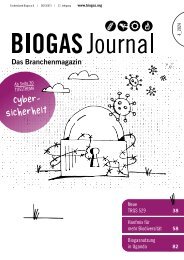You also want an ePaper? Increase the reach of your titles
YUMPU automatically turns print PDFs into web optimized ePapers that Google loves.
Biogas Journal | <strong>Autumn</strong>_<strong>2017</strong> English Issue<br />
The BioChipper by BioG, an Austrian company, is a combined unit. Basically it is a flail mulcher with hammer<br />
flails that crush the maize stubble and the stover. At the same time, the material is picked up via the air suction<br />
produced by the flail shaft and transported onto a cross conveyor belts, which then deposit the stover onto<br />
the windrow. The maize stubble is very short, which is very good for controlling the European corn borer. However,<br />
the machine does not deliver all the stover to the windrow, which is not problematic in practical terms.<br />
ing maize stover potential were harvested<br />
without any loss, the methane yield per<br />
hectare [(stover yield in tonnes dry matter<br />
per hectare * specific methane yields in<br />
Nm 3 CH 4<br />
(t odm) * organic dry matter content]<br />
would be between 3,000 and 3,500<br />
Nm 3 CH 4<br />
per hectare, somewhat less than<br />
half of that for silo maize. The later the harvest,<br />
however, the lower the methane yield<br />
per hectare because the specific methane<br />
yields decrease with increased ripening<br />
(often significantly) and the maize stover<br />
potential is generally reduced. Probably<br />
losses due to disintegration of leaves are<br />
responsible. The variety selected can also<br />
play a role, although due to the pronounced<br />
seasonal effects, a clear effect based on<br />
variety has not yet been confirmed. But<br />
because current grain maize varieties have<br />
not yet been grown for combined use, improvements<br />
can certainly be expected as<br />
cultivation progresses.<br />
Removal rates and methane<br />
yields per hectare<br />
In the harvest technology trial, with a maize<br />
stover potential of 9.8 to 11.7 tonnes per<br />
hectare, average stover yields of 4.6 to 6.3<br />
tonnes dry matter per hectare were removed<br />
under standard practical conditions. That<br />
corresponds approximately with practical<br />
experience: These yields are estimated between<br />
3 to 7 tonnes dry matter per hectare.<br />
Therefore, suitable amounts of substrate<br />
can certainly be recovered, but at the same<br />
time, harvest losses are often still very high<br />
and are frequently of the same magnitude<br />
as the harvest amounts.<br />
All of the harvesting methods tested proved<br />
feasible. In the individual years, significant<br />
differences in the removal rates could be<br />
determined among the four windrowing<br />
technologies; in the three-year comparison,<br />
however, nearly identical removal rates were<br />
obtained. Field choppers and loader wagons<br />
proved to be completely equivalent in terms<br />
of removal rates, although the cutting is<br />
more intensive with the field chopper.<br />
Particularly the harvest conditions also affected<br />
the removal rates. For example, delayed<br />
stover recovery, i.e. the maize stover<br />
remained in the field for a longer period<br />
following the grain harvest, had primarily<br />
a negative effect on the removal rates.<br />
The dry matter contents of the recovered<br />
maize stover varied widely in the individual<br />
trial years and averaged 40 to 45 percent<br />
(2014/2016) and 60 percent (2015). Immediately<br />
before grain threshing, however,<br />
Anlagenbau<br />
Your reliable partner for:<br />
Agritechnica<br />
in Hannover<br />
Hall 23, Stand C35<br />
Substrate preparation and<br />
crushing technology<br />
the right preparation<br />
technology for each<br />
substrate<br />
l Optimatic hammer mill<br />
l with bypass solution<br />
l specifically for fibrous<br />
materials<br />
l Impact Crusher HPZ 1200<br />
l For use with high-wear<br />
substrates or organic<br />
waste, i.e. deep litter<br />
l Throughput: 8 - 12 t/h<br />
Push floor container<br />
l steel construction<br />
l volume 40 - 200 m³, as twin<br />
container up to 300 m³<br />
l sliding frames made<br />
of stainless steel, plastic<br />
lining<br />
l optional dosing- or<br />
disintegrating roller<br />
Pull bottom system<br />
l concrete construction<br />
l upper-underfloor<br />
passable<br />
l volume 80 - 175 m³<br />
l sliding frames made<br />
of stainless steel, plastic<br />
lining<br />
Compact system<br />
l Complete made of<br />
stainless steel<br />
l volume 13 - 33 m³<br />
l with two dosing roller<br />
PART OF THE<br />
HUNING GROUP<br />
HUNING Anlagenbau GmbH<br />
& Co. KG<br />
Wellingholzhausener Str. 6<br />
D-49324 Melle<br />
Phone +49 (0) 54 22/6 08-2 60<br />
Fax +49 (0) 54 22/6 08-2 63<br />
info@huning-anlagenbau.de<br />
15<br />
www.huning-anlagenbau.de

















